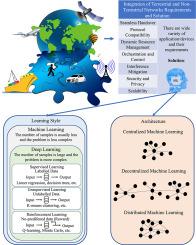以机器学习为驱动整合地面和非地面网络,增强 6G 连接性
IF 4.4
2区 计算机科学
Q1 COMPUTER SCIENCE, HARDWARE & ARCHITECTURE
引用次数: 0
摘要
非地面网络(NTN)对于实现第六代网络的持久连接目标至关重要,尤其是在缺乏地面基础设施的地区。然而,将非地面网络与地面网络整合在一起却面临着诸多挑战。由于 NTN 通信场景的动态性和复杂性,传统的基于模型的资源分配和参数优化方法需要大量计算,往往不切实际。基于机器学习(ML)的解决方案在这方面至关重要,因为它们可以有效识别动态多维数据中的模式,在降低复杂度的同时提高性能。ML 算法根据学习方式(监督学习、非监督学习和强化学习)和架构(包括集中式、分散式和分布式 ML)进行分类。每种方法在不同情况下都有其优势和局限性,因此在地面和非地面网络(TNTN)的集成过程中,为每种特定场景选择最合适的 ML 策略至关重要。本文回顾了第三代合作伙伴项目中概述的 TNTN 集成架构,研究了基于 ML 的现有工作,并讨论了适合各种 TNTN 场景的 ML 学习方式和架构。随后,它通过一个特定场景中的案例研究,深入探讨了不同 ML 方法的能力和挑战。本文章由计算机程序翻译,如有差异,请以英文原文为准。

Machine learning-driven integration of terrestrial and non-terrestrial networks for enhanced 6G connectivity
Non-terrestrial networks (NTN)s are essential for achieving the persistent connectivity goal of sixth-generation networks, especially in areas lacking terrestrial infrastructure. However, integrating NTNs with terrestrial networks presents several challenges. The dynamic and complex nature of NTN communication scenarios makes traditional model-based approaches for resource allocation and parameter optimization computationally intensive and often impractical. Machine learning (ML)-based solutions are critical here because they can efficiently identify patterns in dynamic, multi-dimensional data, offering enhanced performance with reduced complexity. ML algorithms are categorized based on learning style—supervised, unsupervised, and reinforcement learning—and architecture, including centralized, decentralized, and distributed ML. Each approach has advantages and limitations in different contexts, making it crucial to select the most suitable ML strategy for each specific scenario in the integration of terrestrial and non-terrestrial networks (TNTN)s. This paper reviews the integration architectures of TNTNs as outlined in the 3rd Generation Partnership Project, examines ML-based existing work, and discusses suitable ML learning styles and architectures for various TNTN scenarios. Subsequently, it delves into the capabilities and challenges of different ML approaches through a case study in a specific scenario.
求助全文
通过发布文献求助,成功后即可免费获取论文全文。
去求助
来源期刊

Computer Networks
工程技术-电信学
CiteScore
10.80
自引率
3.60%
发文量
434
审稿时长
8.6 months
期刊介绍:
Computer Networks is an international, archival journal providing a publication vehicle for complete coverage of all topics of interest to those involved in the computer communications networking area. The audience includes researchers, managers and operators of networks as well as designers and implementors. The Editorial Board will consider any material for publication that is of interest to those groups.
 求助内容:
求助内容: 应助结果提醒方式:
应助结果提醒方式:


